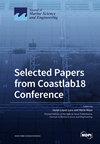斜流对限制水域船舶水动力特性影响的数值研究
IF 2.8
3区 地球科学
Q1 ENGINEERING, MARINE
引用次数: 0
摘要
在狭窄的浅水航道中,斜流的影响导致船舶周围的流体流动变得复杂。要分析船舶在此类水道中的水动力特性,必须研究斜流对船舶水动力特性的影响。本研究将水流方向、船速、流速和水深确定为影响船舶水动力特性的决定因素。对一艘大型油轮进行了数值模拟,以研究这些因素对船舶水动力特性的影响。粘性流体的流动是通过非稳定雷诺平均纳维-斯托克斯(URANS)方程和 k-ε 湍流模型来模拟的。URANS 方程采用有限体积法离散化。数值结果表明,与静水条件相比,斜流条件下船舶的水动力特性存在很大差异。在水流方向为 β = -45° 时,摇摆力的方向与静水摇摆力的方向一致,后者是一种吸引力。β = -45° 时的偏航力矩从静水条件下的船首向外力矩变为船首向内力矩。相反,在水流方向为 β = 45° 时,摇摆力从静水条件下的吸引力转变为排斥力。偏航力矩充当了船首冲出力矩,这与静水条件下观察到的情况一致。此外,水动力特性对船舶的影响随船速、流速和水深的变化而显著不同。为确保船舶航行安全,必须根据实际情况制定和应用全面的策略和对策。本文章由计算机程序翻译,如有差异,请以英文原文为准。
Numerical Investigation of Oblique Currents’ Effects on the Hydrodynamic Characteristics of Ships in Restricted Waters
The influence of oblique currents in narrow and shallow channels causes the fluid flow around ships to become complex. To analyze the hydrodynamic characteristics of a ship in such channels, it is essential to examine the influence of oblique currents on the ship’s hydrodynamic characteristics. In this study, current direction, ship speed, current speed, and water depth were identified as determinants affecting the hydrodynamic characteristics of a ship. Numerical simulations were conducted on a large oil tanker to investigate the effects of these factors on the ship’s hydrodynamic characteristics. The viscous fluid flow was modeled using the unsteady Reynolds-averaged Navier–Stokes (URANS) equations in conjunction with the k-ε turbulence model. The URANS equations were discretized using the finite volume method. The numerical results indicate substantial differences in the hydrodynamic characteristics of ships under oblique current conditions compared to still-water conditions. At a current direction of β = −45°, the direction of the sway force is consistent with that of still water’s sway force, which is an attractive force. The yaw moment at β = −45° changes from a bow-out moment under still-water conditions to a bow-in moment. Conversely, at a current direction of β = 45°, the sway force shifts from an attractive force under still-water conditions to a repulsive force. The yaw moment acts as a bow-out moment, which is consistent with that observed in still-water conditions. Furthermore, the influence of hydrodynamic characteristics on a ship varies significantly with changes in ship speed, current speed, and water depth. To ensure the safe navigation of ships, it is essential to develop and apply comprehensive strategies and countermeasures that account for practical conditions.
求助全文
通过发布文献求助,成功后即可免费获取论文全文。
去求助
来源期刊

Journal of Marine Science and Engineering
Engineering-Ocean Engineering
CiteScore
4.40
自引率
20.70%
发文量
1640
审稿时长
18.09 days
期刊介绍:
Journal of Marine Science and Engineering (JMSE; ISSN 2077-1312) is an international, peer-reviewed open access journal which provides an advanced forum for studies related to marine science and engineering. It publishes reviews, research papers and communications. Our aim is to encourage scientists to publish their experimental and theoretical results in as much detail as possible. There is no restriction on the length of the papers. The full experimental details must be provided so that the results can be reproduced. Electronic files and software regarding the full details of the calculation or experimental procedure, if unable to be published in a normal way, can be deposited as supplementary electronic material.
 求助内容:
求助内容: 应助结果提醒方式:
应助结果提醒方式:


